In my continual search for new and interesting games to do interviews on for our blog, 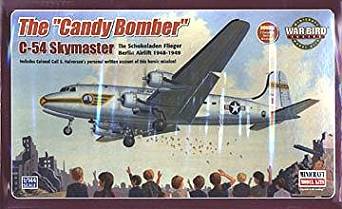 I ran across designer John Poniske who is currently working on several new projects, (see the final question of the interview for the list) including a very unique as yet un-gamed subject called The Berlin Airlift. I have seen a documentary on the Candy Bomber Colonel Gail Seymour Halvorsen, but don’t know much else about this event, which started the Cold War off with a bang. So, thanks to John for his time, and here is the interview:
I ran across designer John Poniske who is currently working on several new projects, (see the final question of the interview for the list) including a very unique as yet un-gamed subject called The Berlin Airlift. I have seen a documentary on the Candy Bomber Colonel Gail Seymour Halvorsen, but don’t know much else about this event, which started the Cold War off with a bang. So, thanks to John for his time, and here is the interview:
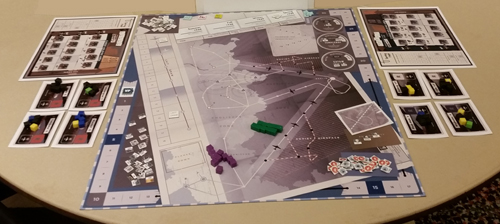
Grant: John, first off tell us a little about yourself. What is your day job? What games do you like to play?
John: I’m an Illinois boy, raised in the capital, Springfield – Abraham Lincoln’s stomping grounds. I grew up in a board-game playing family who instilled in me a love of history, reading and travel. After High School, I joined the Marines where I assisted in the evacuation of the embassies in Saigon and Phnom Penh, Spring od ’75. I’ve traveled to all 50 states, and over 30 countries. I currently teach Civil War, Government and Journalism in an alternative high school in Hagerstown, MD. I conduct a monthly game night at our local church and attend community game sessions with a local group when I have time between work and design obligations. My favorite games include Lincoln’s War, Twilight Struggle, We the People and Family Business.
Grant: How did you get interested in Board game design? What do you love about it? What is the greatest challenge?
John: I’ve always toyed with modifying rules of the games I play and have often been accused by my wife (whom I love very much) of making up the rules as I go. But my serious entry into game design didn’t happen until my good friend and fellow Marine, Rick Young, asked me to review his first design, Europe Engulfed. I was impressed by the scope of the project and the fact that a friend of mine could enter into such an ambitious project. His inspiration led to my entering into a number of projects, mostly Civil War themed. We later coauthored a crazy game, Leaping Lemmings, based on an idea I had while commuting with him to AvalonCon in Lancaster, PA. You ask, what I love about design work? That’s easy – the joy of discovery. Every new design opens a new door into the past and I revel in the joy of attempting to lead others through that same door. Regarding the Berlin Airlift – I knew nothing about the Candy Bomber or Clarence the Camel and I would imagine most people are just as clueless, yet the design will enlighten them. You ask, what is the greatest challenge to design work? Refining the rules so that they are compatible with the desires of the developer, the publisher and most of all the players. I don’t think players (unless they are designers, developers or publishers themselves), are fully cognizant of the thousands of hours that go into the development of the games on their shelves.
Grant: What gave you the idea to design a game on the Berlin Airlift?
John: Honestly, I hadn’t even considered the Berlin Airlift as a game theme until a member of my church and fellow gamer, Dave Thompson, challenged me to do so. His father had been in the US Army Air Corps in Europe during WWII so he had a vested interest. Wargame the Airlift? It was an intriguing concept, one that captured my imagination and wouldn’t let go.
Grant: What is The Berlin Airlift board game about? Is it a Euro game?
John: The Berlin Airlift is a microcosm of the greatest military airlift operation the world has ever seen. It is a race between squadrons of US and British Commonwealth squadrons to deliver necessary supplies to Berlin in the face of Soviet harassment and fluctuating Berliner morale. It is competitive but also has a limited cooperative element because everyone loses if Berliner Morale dips below a certain point. It is a tense lesson in history and amazing willpower. I wouldn’t call it a wargame, nor strictly a Euro. It’s more of a Euro-Wargame.

Grant: What are the main mechanics used in the game?
John: The game relies on a Chit Draw system in which players are never certain whose planes will lift off next and will it be before the weather worsens or the Soviets attempt to divert flights. It also involves cargo cubes representing a variety of commodities (fuel, food, medicine and spare parts) being flown in, while manufactured goods and refugees are being flown out of Berlin.
Grant: What scenarios are included in the game? How long does each take to play?
The scenarios were simple to create as the “lift” lasted approximately one year from the Summer of 1948 to the Spring of 1949. Each of four seasons then becomes a scenario presenting new weather, new planes, new historical circumstances and increasing Soviet involvement. Each scenario lasts 2 hours or less.
Grant: What experience did you want your players to have?
John: We are seeking to provide a great deal of tension between players. This will come from Soviet harassment, unpredictable weather, opponent interference and persistent mechanical failure. Players will also come away from the game with enhanced knowledge of a remarkable military triumph that didn’t rely on shooting and killing.
Grant: How did you go about integrating the theme into the design?
John: Integrating theme into design…that had to do with massive trial and error. After months of back and forthing, Dave and I sometimes found ourselves back where we started. Our goals were to keep the game moving along quickly with minimal downtime for players. We actually began the design as a CDG, which morphed into a design heavily influenced by dice and charts, yet it has ended up a card assisted game with minimal reliance on charts.
Grant: What is the goal of each of the players? How do they go about accomplishing these goals?
John: Each player chooses a squadron, either US or Commonwealth, and depending on the number of players, one to three flights of 3-5 planes per flight. On a player’s flight card are a series of cargo goals that need to be met or exceeded. This is done by successful delivery of cargo to Berlin and successfully flying out of Berlin, refugees and finished products made in Berlin factories. In addition, each player receives a certain amount of “military support”, which can be applied to any number of things.
Grant: What aircraft are used and how do each nation’s planes differ?
John: A wide variety of planes are introduced. The US planes are pretty generic: C47, C-54, C-72, C-82 (This latter monster was only flown once and in the game may not fly at all) and the Commonwealth provides a greater variety of aircraft including Dakotas, Hastings, Yorks, Bristols, Halifaxes, Sunderlands, Lancasters, Tudors and Bristols.
Grant: What advantages does each aircraft provide?
John: Aircraft vary in load capacity and speed and their introduction is dependent on the season. Number and load capacity of planes is limited in the Summer, but increases with each passing season.
Grant: What is the Personality Chart, the Help & Hindrance Chart or the Soviet Harassment Chart and how do they affect gameplay? Do you have images you could share?
John: This is how we introduced the various historical personalities, and a wide variety of soviet harassment as well as an array of historical situations. Except for the Harassment table, which still remains, the remaining information is now included on the cards drawn at the beginning of each turn.
Grant: What determines the cargo that is needed? Does each type of cargo score differently? Do players score points for sets of cargo?
John: Cargo is delivered randomly to Airbases at the beginning of each turn – because of US production levels the US receives a double share. This is offset by the increased distance traveled by US planes and the disparity in US bases vs. Commonwealth bases. The arrival of cargo in airbases is dependent on its rarity. Medicine and spare parts are less likely to arrive as food, which is even less likely to arrive as fuel. Players score points on varying levels of delivery. Points are scored as follows: half of a cargo’s goal, meeting a goal and exceeding a goal. Random points may be scored during the game based on events, otherwise points are scored when the game ends. Cargo in flight when the game ends is considered delivered.
Grant: How is support earned and what can it be used as currency to purchase?
John: A certain amount of support is awarded players at the beginning of each turn. Support might be considered currency and may be increased or decreased depending on historical circumstances as they occur. Support can be applied to the building or repair of airports, assisting mechanical repair, transferring of cargo or key personnel from an opponent’s airport to your own, assisting in mechanical repair, boosting Berliner Morale or even translated directly into VPs.
Grant: Talk about the board and how it functions. Who was the artist? How has it changed through the design and playtest process?
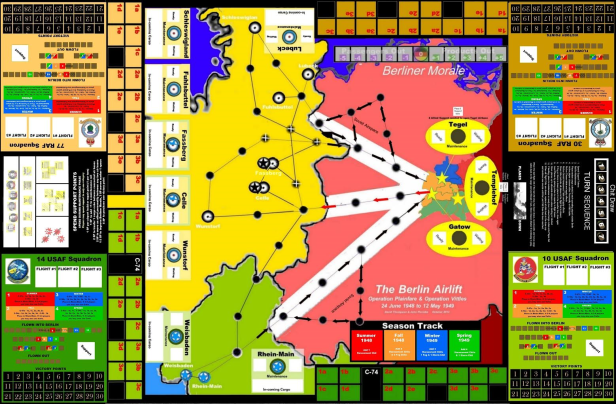
The board is a replication of numerous period depictions of the Airlift area of operations. It identifies the various regions of control operated by the Soviets and the Allies as well as the ingress and egress paths through the Soviet zone to and from Berlin along with the airbases and airports involved in the “Lift.” The artist who translated my poor depiction into a truly iconic work of art is the world-renowned Swedish clothing designer, Nils Johannson. The overall look of the map has changed little from his original presentation other than relocating informational sections and the removal of squadron information from the map to separate player aids.

Grant: What are the flight chits? How are they introduced into game play?
John: Each flight chit represents one of the player’s flights. Flight chits are dropped into a cup along with Weather and Harassment chits which are then drawn randomly by the active player to determine the course of the game.
Grant: How do airbases become inactive? What is a good strategy for their use?

John: Airbases are either active or inactive at the beginning of a season. This is based on the readiness of the allies to begin and continue the “Lift” operation. In the Summer the allies were least ready. By Spring, all airports and airbases were operational. 18. How does the coop nature on Berliner Morale maintenance work? What happens if the morale level is extremely low? You ask about the co-operational nature of the game. It is indeed limited. It is a race between players. But if anyone is to win the game the Berliner morale must be above “0.” To that end, players must arbitrarily cooperate and decide who contributes “support,” if it is needed, to increase Berliner morale.
Grant: How is the Active Player determined? How can the Active Player decide how each player is affected by things such as weather, breakdowns, etc.? How does the Active Player change?
John: The first Active Player is the oldest among the group. Thereafter, the Active Player passes to the left, however the Active Player may change due to historical circumstances. In addition, circumstances may ordain that the game is shortened by a turn or even lengthened by a turn…or both. The Active Player is the first to use support in a turn and also directs the targets of Soviet harassment. (Note that harassment only occurs on the incoming flight paths so it is possible that the Active Player will have to direct harassment to his own planes if an opponent’s planes are not available.)
Grant: I understand that each round an event card is drawn. Can you give us a few examples of the text on these cards so we can see the types of effects to expect?
John: Here are a few examples of some of the cards text. Note that these cards are not in final form and haven’t had art included or been formatted.
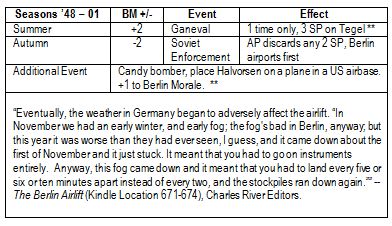

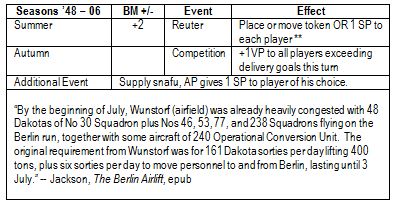
Grant: How are Victory Points scored?
John: As to victory points – VPs are scored based on the level of goals accomplished in each cargo category, those scored based on direct payment of support, as well as those deducted for downed aircraft.
Grant: Is there a solo variant and does it work well?
John: Yes there is a solo variant and it does work well as there is no hidden information.
Grant: What has changed through the playtest process? Please give specific examples.
John: Regarding changes in the design process – as I said, the reintroduction of cards was a major change, this reduced die roll wrist action and also reduced the complexity of having to use additional charts. Also, removing the squadron information to individualized player aids made flight manipulation easier. And finally, the ebb and flow of cargo cubes onto and off of the board has been refined to where we are now happy that we have arrived at the “cubal sweet spot.”
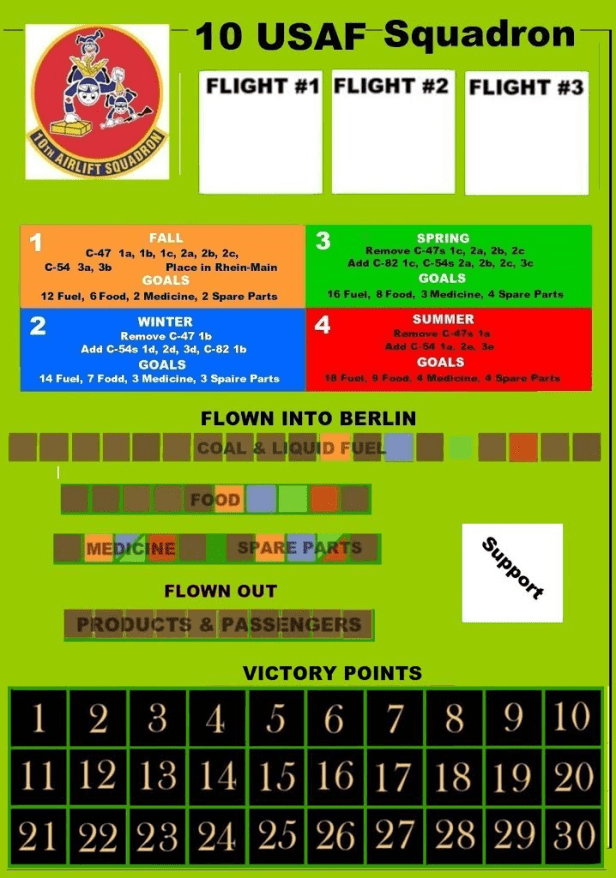
Grant: What is the schedule for the game?
John: Current thinking on the Kickstarter launch is sometime during the fall of 2017. This has been pushed back due to the success that Legion has experienced with CPO orders for other games including Target for Today and Demyansk Shield.
Grant: What others projects are you working on?
John: I am currently finishing up a design with Bill Morgal for Compass Games on the first two conflicts of the Revolutionary War (The British March on Concord and Bunker Hill) titled Revolution Road. Also in the works for Compass is The Battle of Belmont (Grant’s initial battle in the Civil War), Blood on the Ohio (The struggle over settlement in the Ohio territory after the Revolution) and Wolfe Tone’s Rising (the Irish Rebellion of 1798). GMT is in final development of Plains Indian Wars. Besides The Berlin Airlift, which will be kickstarted, Legion Wargames will be releasing Maori Wars (The British settlement of New Zealand) shortly and thereafter Fire on the Mountain (The Battle of South Mountain which preceded the Battle of Antietam). Decision Games is currently refining The Banana Wars (US involvement in the Caribbean at the turn of the 20th century), Bleeding Kansas (The abolitionist struggle for control of the soul of Kansas), and Company Clash (a Civil War deck building game on the company level). I probably forgot something as I am juggling a lot right now. [Editors Note: With this many new games being worked on by John, he and I may get to know each other pretty well over the next several months, as I plan to reach out to him for interviews on most of the games he listed here!]

Thanks John for your time and for the great insight into this very interesting looking historical game based on an as yet un-gamed subject. If you are interested in learning more about the game, please visit it’s CPO page on Legion Wargames at the following link: http://www.legionwargames.com/legion_BER.html and look for the Kickstarter campaign sometime later this fall!
-Grant




Thank you for this excellent interview with Mr. Poniske.
Berlin Airlift is on my Legion Wargames CPO list together with Maori Wars (that fantastic map!) and Miracle at Dunkerque. I recon this will be fine game.
LikeLiked by 1 person
I also have it on CPO. I love Legion Wargames. Great little company! Thanks for reading.
LikeLike
Another fine interview. John is always an interesting interview subject. Sounds like he has a lot of design irons in the fire, best of luck to him.
LikeLike